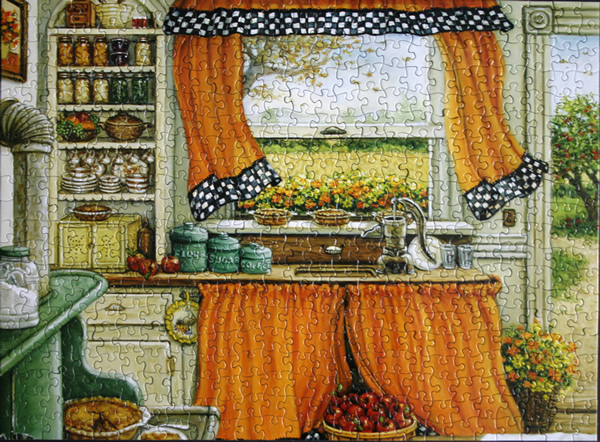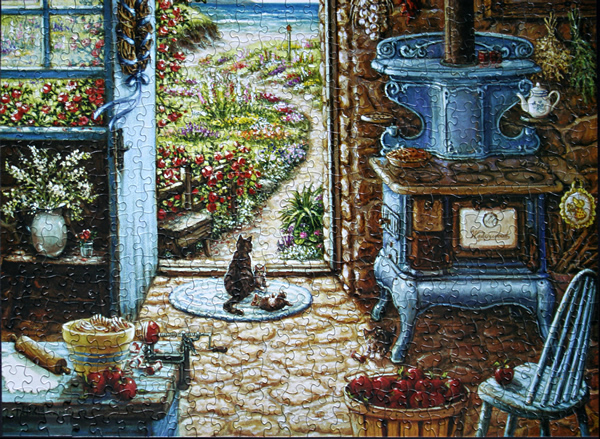
Size: 550 pieces
Dimensions: 61 cm x 46 cm
Producer: Ceaco, Culinary Classics series, 1999, #2319-6
Notes: A lovely and zen puzzle to assemble. There are many ways to approach it: I have started with the tallest bottle and the tall jar with orange contents, followed by the red flowers and the blue fence in the background. The red peppers, white towel and garlic, the basket, and cut up lemons and limes followed. The fruit in the basket and under it came after, and the rest of the pieces came together easily then.
Tag: kitchen
Puzzle: Pie baking day by Janet Kruskamp

Size: 500 pieces
Dimensions: 45.26cm x 35.56cm
Producer: Sure-Lox, The Canadian Group, Country Kitchen series, 2011, #42225-3
Artist: Janet Kruskamp
Puzzle: The orange curtains and the checkered parts are an easy place to start. Flowers on the window sill, apples, edge of the green table, sky, and tree can follow. The pipe, door frame, garden, and beige cupboard can be finished next, leaving the cans, dishes, and a few other small areas to complete. Very pleasant and staightforward puzzle. It also includes a shortbread cookies recipe and a red puzzle piece cookie cutter.
Baking: In ancient history, the first evidence of baking occurred when humans took wild grass grains, soaked them in water, and mixed everything together, mashing it into a kind of broth-like paste. The paste was cooked by pouring it onto a flat, hot rock, resulting in a bread-like substance. Later, this paste was roasted on hot embers, which made bread-making easier, as it could now be made anytime fire was created.
In ancient history, the first evidence of baking occurred when humans took wild grass grains, soaked them in water, and mixed everything together, mashing it into a kind of broth-like paste. The paste was cooked by pouring it onto a flat, hot rock, resulting in a bread-like substance. Later, this paste was roasted on hot embers, which made bread-making easier, as it could now be made anytime fire was created. [Wiki]
Puzzle: Blue Stove by Janet Kruskamp

Size: 500 pieces
Dimensions: 45.26cm x 35.56cm
Producer: Sure-Lox, The Canadian Group, Country Kitchen series, 2011, #42225-1
Artist: Janet Kruskamp
Puzzle: I have started this one with the blue regions: the door, the stove, the rug, and the chair. Window frame, white flowers in the vase, red apples, bowl on the table, the vase, the plaque on the stove, and the garden path are smaller self-contained regions. The flower garden and the light part of the floor easily fall into place, and the brown under the vase and all around and on the stove are the more subtle parts left over. Not a hard puzzle to do, it helps to have natural light at the end. The puzzle includes a shortbread cookies recipe and a red puzzle piece cookie cutter.
Stove: The Old English word stofa meant any individual enclosed space, such as a room, and ‘stove’ is still occasionally used in that sense, as in ‘stoved in’. Until well into the 19th century ‘stove’ was used to mean a single heated room, so that Joseph Bank’s assertion that he ‘placed his most precious plants in the stove’ or Rene Descarte’s observation that he got ‘his greatest philosophical inspiration while sitting inside a stove’ are not as odd as they first seem.
In its earliest attestation, cooking was done by roasting meat and tubers in an open fire. Pottery and other cooking vessels may be placed directly on an open fire, but setting the vessel on a support, as simple as a base of three stones, resulted in a stove. The three-stone stove is still widely used around the world. In some areas it developed into a U-shaped dried mud or brick enclosure with the opening in the front for fuel and air, sometimes with a second smaller hole at the rear. [Wiki]
Puzzle: Canning Day by Janet Kruskamp

Size: 500 pieces
Dimensions: 45.26cm x 35.56cm
Producer: Sure-Lox, The Canadian Group, Country Kitchen series, 2011, #42225-2
Artist: Janet Kruskamp
Puzzle: A logical starting point are the checkered curtains, followed by the yellow batches of colour and the stove. Floor boards, white table, garden path and flowers, the patches of sky, and the vegetables make stand-alone regions that are easy to put together. Door frame and window frame logically fall into place. The rug, corn, and places under the stove follow, to leave only the cupboards and a few dark areas. Easy and fast puzzle to do. It also includes a shortbread cookies recipe and a red puzzle piece cookie cutter.
Canning: Canning is a method of preserving food in which the food contents are processed and sealed in an airtight container. Canning provides a typical shelf life ranging from one to five years, although under specific circumstances a freeze-dried canned product, such as canned, dried lentils, can last as long as 30 years in an edible state. In 1795 the French military offered a cash prize of 12,000 francs for a new method to preserve food. Nicolas Appert suggested canning and the process was first proven in 1806 in test with the French navy and the prize awarded in 1809 or 1810. The packaging prevents microorganisms from entering and proliferating inside.
To prevent the food from being spoiled before and during containment, a number of methods are used: pasteurisation, boiling (and other applications of high temperature over a period of time), refrigeration, freezing, drying, vacuum treatment, antimicrobial agents that are natural to the recipe of the foods being preserved, a sufficient dose of ionizing radiation, submersion in a strong saline solution, acid, base, osmotically extreme (for example very sugary) or other microbially-challenging environments. [Wiki]
Puzzle: Early summer produce

Size: 500 pieces, 1 missing
Dimensions: 35.24cm x 50.48cm
Producer: MB Puzzle, Croxley series, 1997, #4611-22
Puzzle: Pleasant puzzle, preferably done with good lighting. Lots of green, grey, and brown, but easy enough to assemble. Several bright regions (strawberries, onions, window, and walls) as well as the horizontal and vertical surfaces lay a good foundation to guide the completion of the puzzle.
Produce: Produce is a generalized term for a group of farm-produced crops and goods, and is not limited to fruits and vegetables (i.e. meats, grains, oats, etc. are sometimes considered as produce.) More specifically, the term “produce” often implies that the products are fresh and generally in the same state as where they were harvested. Produce is the main product sold by greengrocers, farmers’ markets, and fruit markets. [Wiki]





